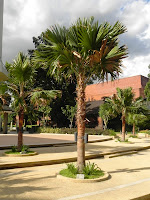Two years ago, the famous bell tower, the Carillon, was refurbished. Apart from reviving the hourly chimes of its famous bells, the grounds were also given a facelift via a proper landscaped plaza designed by Prof. Horacio Dimanlig.  The design made use of the popular exotic royal palm or Roystonea sp. (from the Caribbean) to further frame the tall structure. But a year after the royal palms succumbed to transplant shock leaving again the Carillon as the sole straight mass in the area.
The design made use of the popular exotic royal palm or Roystonea sp. (from the Caribbean) to further frame the tall structure. But a year after the royal palms succumbed to transplant shock leaving again the Carillon as the sole straight mass in the area.
 This morning I was happy to find that the dead royal palms were already replaced with a new plant species. Since also a year ago, a memo was passed to only allow native trees to be planted in any U.P. campus, the new palms had to be Philippine indigenous. The palm they used is anahaw or Livistona rotundifolia. It is a fan palm that could grow straight and tall, elegantly framing the majestic Carillon (and will not compete with it in terms of bulk).
This morning I was happy to find that the dead royal palms were already replaced with a new plant species. Since also a year ago, a memo was passed to only allow native trees to be planted in any U.P. campus, the new palms had to be Philippine indigenous. The palm they used is anahaw or Livistona rotundifolia. It is a fan palm that could grow straight and tall, elegantly framing the majestic Carillon (and will not compete with it in terms of bulk).  The only downside is that most fan palms are harder to transplant, which is why the specimens planted in the Carillon were younger and shorter species. These will have a better chance to survive than full grown plants. Hopefully in a handful of years we'll get to see the intended aesthetic effect of these anahaws, giving the proper drama for the beloved landmark.
The only downside is that most fan palms are harder to transplant, which is why the specimens planted in the Carillon were younger and shorter species. These will have a better chance to survive than full grown plants. Hopefully in a handful of years we'll get to see the intended aesthetic effect of these anahaws, giving the proper drama for the beloved landmark.
 The design made use of the popular exotic royal palm or Roystonea sp. (from the Caribbean) to further frame the tall structure. But a year after the royal palms succumbed to transplant shock leaving again the Carillon as the sole straight mass in the area.
The design made use of the popular exotic royal palm or Roystonea sp. (from the Caribbean) to further frame the tall structure. But a year after the royal palms succumbed to transplant shock leaving again the Carillon as the sole straight mass in the area. This morning I was happy to find that the dead royal palms were already replaced with a new plant species. Since also a year ago, a memo was passed to only allow native trees to be planted in any U.P. campus, the new palms had to be Philippine indigenous. The palm they used is anahaw or Livistona rotundifolia. It is a fan palm that could grow straight and tall, elegantly framing the majestic Carillon (and will not compete with it in terms of bulk).
This morning I was happy to find that the dead royal palms were already replaced with a new plant species. Since also a year ago, a memo was passed to only allow native trees to be planted in any U.P. campus, the new palms had to be Philippine indigenous. The palm they used is anahaw or Livistona rotundifolia. It is a fan palm that could grow straight and tall, elegantly framing the majestic Carillon (and will not compete with it in terms of bulk).  The only downside is that most fan palms are harder to transplant, which is why the specimens planted in the Carillon were younger and shorter species. These will have a better chance to survive than full grown plants. Hopefully in a handful of years we'll get to see the intended aesthetic effect of these anahaws, giving the proper drama for the beloved landmark.
The only downside is that most fan palms are harder to transplant, which is why the specimens planted in the Carillon were younger and shorter species. These will have a better chance to survive than full grown plants. Hopefully in a handful of years we'll get to see the intended aesthetic effect of these anahaws, giving the proper drama for the beloved landmark. 
No comments:
Post a Comment